 On this winter’s day, the backyard bird feeder is bustling with a visit from the Finch and Sparrow families. With strong appetites, the birds plow through the offerings of seeds and nuts. Standing on the platform feeder scarfing down seeds or clinging to the tiny pegs on the tube feeders, these birds feed and flutter, fly away and return. It is a wonder there aren’t more midair collisions. On this winter’s day, the backyard bird feeder is bustling with a visit from the Finch and Sparrow families. With strong appetites, the birds plow through the offerings of seeds and nuts. Standing on the platform feeder scarfing down seeds or clinging to the tiny pegs on the tube feeders, these birds feed and flutter, fly away and return. It is a wonder there aren’t more midair collisions.
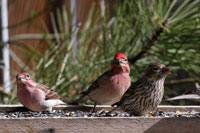
In the birding world, these small songbirds might be known as “LBJs” or Little Brown Jobbers. Often ignored by beginning birders due to identification issue, the bird’s drab coloration and constant movement can make identification challenging. However, their abundance and tolerance for humans provides ample opportunities to view these birds up close. And if they spook, you know they’ll be back.
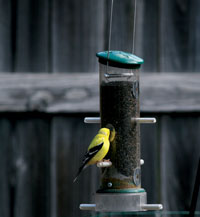 The Finch and Sparrow families include over 70 species in North America. Made up of sparrows and towhees, buntings and longspurs, juncos and crossbills, finches and siskins, these members share traits with their respective relatives. Their cone-shaped bills, relatively pointed wings and short, notched tails hint at these relationships. The conical bills are designed for crushing seeds or cracking shells, although the birds will snag insects or fruit. They are gregarious in nature, often found in mixed flocks or groups of one species. There may be a “teapot of towhees” or a “development of finches.” The collection of nouns describing these collectives are about as interesting as the birds themselves. The Finch and Sparrow families include over 70 species in North America. Made up of sparrows and towhees, buntings and longspurs, juncos and crossbills, finches and siskins, these members share traits with their respective relatives. Their cone-shaped bills, relatively pointed wings and short, notched tails hint at these relationships. The conical bills are designed for crushing seeds or cracking shells, although the birds will snag insects or fruit. They are gregarious in nature, often found in mixed flocks or groups of one species. There may be a “teapot of towhees” or a “development of finches.” The collection of nouns describing these collectives are about as interesting as the birds themselves.
The Finch family is well represented by the reddish house finches, sometimes called “Hollywood finches.” Native to the eastern United States, these birds were introduced into California. Populations flourished and spread across the U.S. to all 48 lower states. An occasional Cassin’s finch is sometimes spotted in the mix, as well as various colored house finches that sport red, orange or yellowish feathers.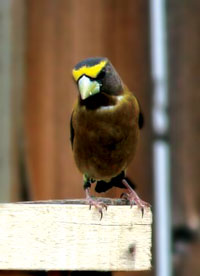
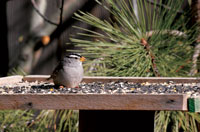 Another group of backyard finches that brightens any dreary day are the American goldfinches or lesser goldfinches. Both sport yellowish undersides, but the lesser is blacker on the back and the nonbreeding American goldfinch will have a much drabber appearance. A real treat is winter is a flock of gray-crowned or black rosy-finches, birds smaller than their names, that descend from their summer alpine haunts to lower elevation wintering spots. Hopping about on the ground in search of seeds or insects. A flock of rosy-finches is known as a “bouquet.” Another group of backyard finches that brightens any dreary day are the American goldfinches or lesser goldfinches. Both sport yellowish undersides, but the lesser is blacker on the back and the nonbreeding American goldfinch will have a much drabber appearance. A real treat is winter is a flock of gray-crowned or black rosy-finches, birds smaller than their names, that descend from their summer alpine haunts to lower elevation wintering spots. Hopping about on the ground in search of seeds or insects. A flock of rosy-finches is known as a “bouquet.”
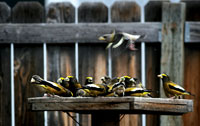 Although not as colorful as the finches, sparrows have distinctive plumages and facial markings that sometimes require a little more inspection. Some species sport a wide variation in their plumages, and as a group can be challenging to identify. Although not as colorful as the finches, sparrows have distinctive plumages and facial markings that sometimes require a little more inspection. Some species sport a wide variation in their plumages, and as a group can be challenging to identify.
Fortunately, two birds - the brilliantly colored spotted towhee and duller dark-eyed junco - both wear a hood of dark feathers that reminds me of the medieval hangman. However, these two species are distinct in size and the towhee has a red eye while the junco has a dark one.
In town, flocks of white-crowned and house sparrows, unwanted guests from Europe, congregate in thickets, shrubby areas and, in the case of house sparrows, nest in building eves or barns. The Old World house sparrows have pretty markings, but their aggressive behavior comes at a price against native species.
So this year’s resolution is to not ignore the LBJs, but to give them a second look. Or a third, depending upon my ID skills.
| Damian Fagan is an accomplished writer who has published a number of guide books as well as numerous articles. If you would like to read more or find out what Damian is up to follow this link to Damian Fagan's blog. |
Winter Recreation in the La Sal Mountains |
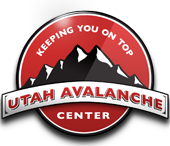 When the weather in Moab gets cold, freezing the Colorado River and putting snow and ice on everybody’s favorite bike trail or climbing route, there is another alternative available. Find yourself in an inversion? It is time to go and discover the recreation opportunities in the La Sal Mountains. When the weather in Moab gets cold, freezing the Colorado River and putting snow and ice on everybody’s favorite bike trail or climbing route, there is another alternative available. Find yourself in an inversion? It is time to go and discover the recreation opportunities in the La Sal Mountains.
The La Sals are second only to the Uintas as the highest peaks in the state of Utah. These mountains soar to almost 13,000 feet above sea level and over 8,000 feet above the valley floor. A laccolith process formed the La Sals. With this process, a mass of igneous rock intruded between layers of sedimentary rock, resulting in uplift. You could call them frustrated volcanoes too. Aside from the volcanoes of the Pacific-Northwest, there are no peaks with greater rise in the continental U.S.
Winter recreation in the La Sals includes cross country skiing, skate skiing, snowshoeing, sledding, back-country skiing and snowmobiling. The winter access to the mountains is provided from two routes kept open by the Grand and San Juan County Road Departments.
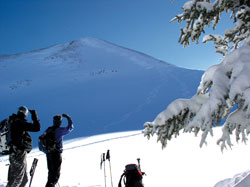
1. The La Sal Mountain Loop Road is plowed regularly. The Geyser Pass road is kept open to the restrooms and parking area at 9,600’. The Geyser Pass Road and Gold Basin Road beyond the winter trailhead is a popular area for cross country skiing, snowshoeing and snowmobiling. Groomed trails are provided by the Lower Utah Nordic Alliance (LUNA). Volunteers groom trails approximately twice a week, which provide 12 kilometers of a groomed trail-system, open to every winter user group. These roads also provide access to backcountry skiing and snowboarding in the Mt. Tomasaki and Gold Basin areas. There is a sledding hill just below the parking lot. If you are using the sledding hill, please park in the parking lot so other vehicles can get to the parking lot. The road in the winter is narrow enough!
Snowmobiles are not allowed to leave the road in Gold Basin. Please respect this closure of the most popular skiing area in the La Sals - the rest of the entire range is open to you!
2. From near Old La Sal at the south end of the range, the road is plowed regularly two miles short of Dark Canyon Lake, just below Mount Peale. The San Juan Road Department makes a parking lot at about 9,600’.
Winter Huts are available for rent from…
Tag-A-Long Tours: 435-259-8946. These simple cabins are great for folks who want to spend several days in the mountains, but don’t want to lose a couple of hours driving back and forth from town every day. The hut operators can snow cat your supplies and camping gear in for you saving you the heavy carry.
Avalanche Hazard
in the La Sal Mountains
The La Sals are rubbly piles of fractured stone.
The angle of repose for this broken stone is 38 degrees, and since snow is also a granular substance, 38 degrees is the bulls-eye slope angle for snow avalanches. Keep in mind though, that avalanches run on terrain from 30 - 45 degrees. Most people caught in avalanches are in terrain that is 30 - 35 degrees of steepness. The La Sal Mountains usually possess one of the weakest snow packs imaginable.
Why do we care? Because 30% of people completely buried by avalanches are killed by trauma and many of those remaining die from suffocation. These are not good odds. It’s not good policy to plan on outrunning an avalanche, even on a fast snowmobile, because avalanches have been clocked at well over 200 mph. Grim statistics showing that snowmobilers are the most likely people to be killed in avalanches also support this.
So what do we do? Fortunately, staying safe doesn’t have to mean staying at home! The good news is that most people trigger the slide that catches them, so if we learn a little about snow and adjust our behavior to suit the conditions, we can continue to enjoy our winter playground!
The Utah Avalanche Center - Moab exists to help you make the right decisions. The Utah Avalanche Center - Moab Forecasters examine the snow and produce an advisory informing you of where you are most likely to run into problems and just how sensitive the snow is. They also produce a mountain weather forecast, work with the Moab Winter Search and Rescue Team and provide avalanche education to the community in numerous ways. The Utah Avalanche Center - Moab educates the community through the advisories, classes held periodically, radio announcements on the weekends on KZMU, the website and at the Geyser Pass Trailhead information board. The center director is Max Forgensi. For more information you can contact Max Forgensi at 435-636-3355
The website is a great tool for:
• Finding a weather forecast for the Moab area,
including radar images
• A current photo gallery of the La Sal Mountains
• Advisories for the La Sals and the Abajo Mountains
• A current course schedule for southeast Utah
Watch for periodic special events like ski swaps and avalanche awareness classes. If you need to talk to one of the avalanche forecasters, please call 259-7155 Monday-Friday during normal business hours and be sure to mention you read about it in Moab Happenings.
For Current Advisories
259-SNOW (7669)
888-999-4019
www.utahavalanchecenter.org
or on facebook.com at
the UtahAvalancheCenterMoab site |
Avalanche Classes
On Friday evening, January 18th at 6:30 pm at the Grand County Public Library, there will be a Basic Avalanche Awareness talk for the public. The following morning, Saturday, January 19th, @ 10:00 am, there will be a follow up on the snow beacon training for interested individuals.
For those who are interested in a more detailed training, the Utah Avalanche Center - Moab will be conducting a 3 day American Institute for Avalanche Research and Education (AIARE) Level I class from February 1st - 3rd...weather dependent. The course will cost $150, proceeds of which will go to the Friends of the La Sal Avalanche Center, a non-profit organization partnered with the UAC-Moab.
Details on this class will be found at the website and facebook page.
|
|
|